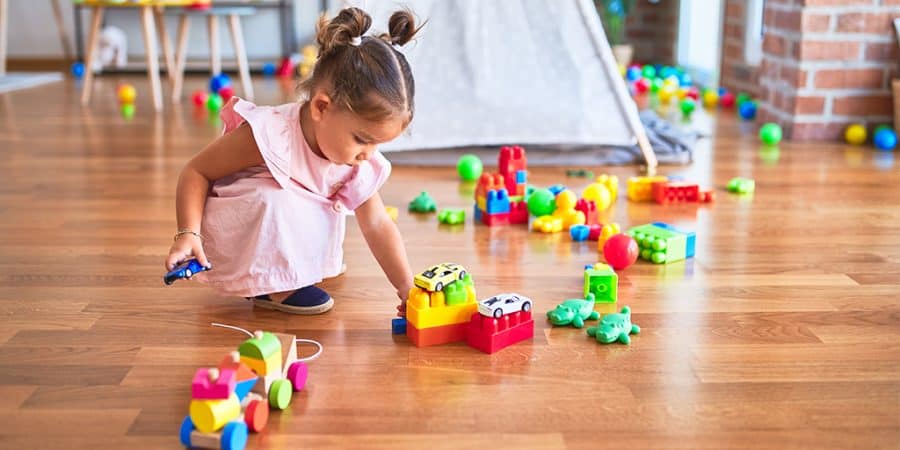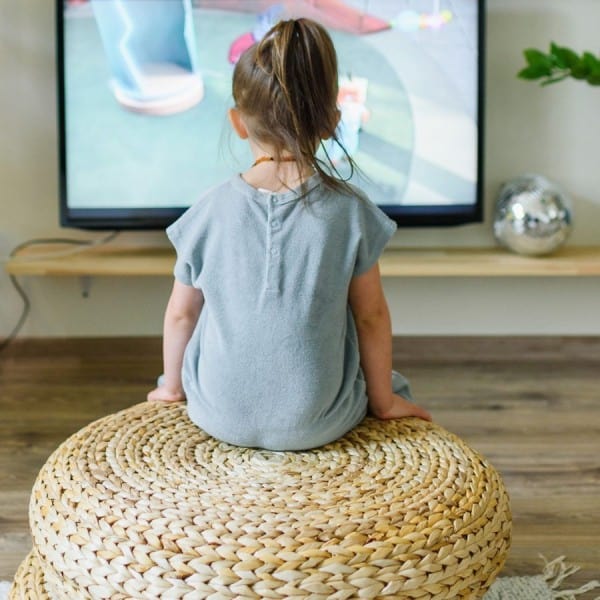Love it or hate it, screen time for kids is here to stay. Now more than ever, it is an inevitable part of our children’s daily lives to teach, entertain, and stay connected to family and friends.
You might ask yourself, “How much screen time is healthy?” or “How much screen time is too much?” How do we use technology positively?
What can we do to balance screen use and other healthy habits? What are some screen time alternatives? Dive in below for answers, tips, and recommendations.

What is screen time?
First, let’s define screen time. According to Merriam-Webster’s Dictionary, it is “time spent watching television, playing a video game, or using an electronic device with a screen (such as a computer, smartphone, or tablet).”
Screen use involves inactive and sedentary activities, often replacing recommended physical activity. So, what is the recommended screen time for kids?
Kids And Screen Time
For good reasons, pediatricians have urged parents to monitor screen time for children. There are real concerns about young children spending too much time in front of a screen.
The challenge is looking for a positive and healthy balance between kids and screens. What’s suitable for one family may not work for another.
Screen Time Recommendations By Age
Experts like the AAP, CDC, and WHO have similar recommendations based on a child’s age; however, it is up to you and your family to decide what works best.
AAP screen time recommendations include:
- Avoid screen time for toddlers younger than 18 months, except for video chatting with family.
- For toddlers ages 18-24 months, limited digital media may be introduced through co-viewing high-quality programs like Sesame Workshop (Sesame Street) and PBS Kids.
- Screen time for preschoolers ages 2-5 should be limited to 1 hour per day of quality programming. Read about preschool-age children and screen use.
- Recommended screen time for kids ages 6 and up, limit the device type and media use to not interfere with family interaction, physical activity, sleep, reading, and reflective downtime. Read more about screen use and academic performance.
The World Health Organization published its own set of guidelines that take the AAP’s recommendations further.
So, how much screen time is healthy?
It is not just about the quantity of time spent watching a digital screen but also the quality of the content, the positive effect, and co-viewing. The most important thing is engagement. If the time you spend together as a family is quality screen-free time, then a little screen use here and there is fine.
To help guide you in selecting age-appropriate and quality media programming, our trustworthy go-to resource is Common Sense Media. Here you will find useful suggestions and reviews for TV shows, movies, educational games, and apps.
How Much Screen Time Is Too Much?
Spending too much time on apps, playing games, or watching YouTube videos is not healthy. Furthermore, videos directed at very young children, despite the claims, do not improve their development.

So, how much is too much? Ask yourself, “Is screen time interfering with more important things?” For example, is it replacing…
- Adequate sleep
- Physical activity
- Family time
- Social interactions
- Playtime (like block play, outdoor play, exploratory play, or all other play types.)
If you see your child’s screen use interfering with any of the above activities, continue reading for ways to get back to a healthy balance.
What Are The Effects Of Too Much?
More studies are needed, but concerns include the effect of too much screen time on toddlers’ childhood development, including gross motor, social-emotional, language, and cognitive development.

Too much screen use can impact how well children sleep at night and put them at risk for anxiety, depression, and learning difficulties, precisely attention problems.
Increased screen time diminishes creativity and problem-solving.
Less physical activity and more sedentary activities like screen use increase the risk of obesity.
- Not to mention, ads for unhealthy foods can lead to poor food choices.
- Finally, sitting in front of a screen is often associated with mindless snacking.
Too much screen time for kids can affect their vision.
- Ensure your child keeps the screen 20 inches from their eyes.
- Take breaks every 20 minutes to reduce eye strain.
- Pay attention to room lighting and avoid using devices in overly bright sunlight or dark rooms.
How to limit screen time?
Limiting screen time for kids can be challenging, especially under the current circumstances. However, good screen time habits start with you. We all want to instill a healthy balance and relationship with technology.
Forming good habits early is important, so create best practices, set limits, and model good screen time behavior.
Try These Tips To Help You Manage The Recommended Screen Time For Kids
Limiting Children’s Screen Time
Previously, the AAP’s recommendations have been clear; however, with COVID-19, things have temporarily changed.
While the AAP does not provide a new number of recommended hours of screen use, it instead focuses on positive, educational, and quality content.
One thing that has not changed is making sure that technology is not interfering with more important activities. They are also not suggesting you throw out all the good habits you have developed.
Instead, do your best, create a daily plan that works for your family, and cut yourself some slack.

TV time for kids
TV plays a large role in how much screen time young children consume. Often, it is nothing more than a distraction or background noise.
Try these simple ways to cut TV time for kids.
- Turn off the TV during other activities and mealtimes.
- Use music as background noise rather than turning on the TV.
- Create a schedule of TV programs to enjoy together. Then, turn off the TV when finished so as not to mindlessly continue watching. Work with your preschooler to decide what’s important to watch. At first, you will have to make the decision, but gradually, they learn to problem-solve and self-regulate by involving them in the process.
- If you find it difficult to move your child away from their favorite TV show or game, look for hands-on activities, such as books, puzzles, or activities about the same subject—for example, pirates, princesses, or superheroes.
- Observe the type of TV shows, video games, or other media apps that ramp up aggression, negative attitudes, or anxiety. Then avoid them!
- An occasional movie night is a great way to relax as a family. However, consider other screen-free activities, such as family game nights, puzzles, or going for a bike ride.
- Balance the amount of time spent on TV or screens with the same amount of time engaged in physical activities. For example, if your child spends 60 minutes watching TV, they would spend 60 minutes playing outside, riding a bike, or running relays.
- Instead of watching TV, encourage interactive activities that support brain development, like playing, talking, singing, and reading together.
- Except for the occasional family popcorn and movie night, keep eating separately from watching TV and other screen use.
Encourage Play, Especially Outdoor Play
Kids need daily play and physical activity. As a matter of fact, the CDC recommends at least 60 minutes a day. If you can’t get outside, try yoga for kids, turn on some music, and have a dance party or even musical chairs to get them moving.
It is important to schedule physical activity daily, even if it is just a family walk after dinner.

Establish Adequate Sleep
Children, depending on their age and development, need 10+ hours of sleep daily. In addition to getting the recommended amount of sleep, establish no screen time for 1-2 hours before bed. Studies show that blue light affects the quality and natural sleep patterns.
Create Screen-Free Zones
The most important screen-free zones are the kid’s bedrooms, the dining room, and a place for activities or homework.
- Make bedrooms a screen-free zone. Remove TVs, computers, video games, and other devices from your child’s rooms. Establishing the bedroom as a screen-free zone now while the kids are young will help build healthy habits when they become teenagers. Many teens have been known to stay up all night texting and chatting.
- Mealtime should be kept sacred for open communication and family connection. Furthermore, not being glued to a digital device while eating helps to create healthy habits.
- Setting up a place for play activities or homework (older children) that is screen-free removes distractions and allows your child to be engaged.
Make It A Family Activity
To avoid having family members isolated somewhere glued to their devices, engage in screen time together. Find something to watch that everyone will enjoy; this allows you to monitor the content and have a conversation afterward.
Model Good Screen Time Behavior
Set limits for your own screen use. Engage in focused quality time with your child daily (use do not disturb on your phone.)
Establishing this focused time may reduce other attention-seeking behaviors at different times. Avoid using your phone or TV to escape.
Avoid Using Digital Devices As Child Care
Rather than handing over your smartphone or putting your child in front of the TV, look for alternative activities to entertain them. Books, playdough, art supplies, puzzles, or open-ended toys like wooden building blocks are all great alternatives.
There is a link between social-emotional delays in children when media has been used as a calming tool. Set up a toolbox of activities that you can use to calm kids or redirect their attention. Check out the Elmo Belly Breathe video.
Positive Use Of Technology
We must not look at all screen use as bad but instead focus on technology’s positive advantages. Experts acknowledge that moderate use of digital devices has a place in our lives and is not harmful.
However, they concur that reducing the amount of time spent in front of a screen is important for our mental and physical well-being. Review the list below for positive ways we use technology.
- Technology has its place in education. Without it, how would our children have gone to school during this pandemic?
- Technology grants us access to learning new skills like gardening, cooking, or crafts.
- We can visit places like museums, national parks, and zoos virtually.
- Enjoying recreation and physical activity like yoga, movement, dance, and music classes for kids and parents through online technology.
- Staying connected with family and friends through technology is crucial in a time of significant social distancing from those we love.
- Using technology to check in on our neighbors and those that might be feeling isolated.

Screen Time Alternatives
One way to find a healthy balance with technology is to put down the devices and play more. Below are several suggestions for less screen time and more playtime!
- Enjoy Physical Games: Try playing Freeze Tag, Simon Says, or Red Light, Green Light. Try some fun obstacle courses or relay races with giant building blocks.
- Read Traditional Printed Books: Research indicates that reading printed books rather than on a digital device resulted in better comprehension.
- Make Music: No instruments? No problem! Get out some wooden spoons, pots, and pans to make music.
- Create Art: Providing blank paper and crayons, markers, and paints allows your children the freedom to express themselves. Keep a box of art supplies on hand, like pipe cleaners, pom poms, and more, for fun spur-of-the-moment projects. Or take your art outside with sidewalk chalk. Want a done-for-you solution for STEAM/STEM activities? Try Green Kids Crafts!
- Cook Together: Involve the kids in choosing and making healthy lunches and snacks. Let the kids help with meal planning and prep. Maybe they get to pick and help prepare the dessert. The more they are involved, the more likely they are to eat better.
- Dance: Kids love music and dancing.
- Get Outside: Go on a scavenger or adventure walk. How about a bike ride, hike, or walk to the park? To really enjoy the time, leave your phone at home (or if concerned about safety, put it on Do Not Disturb.)
- Play More: Enjoy imaginative play or block activities to gain insight into your child’s thoughts, feelings, imagination, and creativity.
- Board Games: Play stimulating, fast-moving board and card games.

A list of articles filled with both indoor and outdoor activities to keep toddlers and preschoolers Busy.
Playing With Magnets: 8 Fun Activities For Toddlers
Easy STEM Activities: Quick & Exciting Engineering For Toddlers
Simple And Powerful Language Activities For Preschoolers
25+ Fun and Helpful Fine Motor Activities For Preschoolers
Gross Motor Activities For Preschoolers: 25+ Quick and Easy
18 More! Easy Social-Emotional Activities For Preschoolers
17+ Easy Social Activities For Toddlers And Preschoolers
Simple Block Activities For Toddlers And Preschoolers
When Do Kids Learn Colors? All In Good Time!
Outside Activities | Blocks for On-The-Go Exploration
Indoor Activities For Toddlers: How To Keep Your Little One Busy
Screen Time For Children
These are unprecedented times and, at the very least, challenging. Give yourself a little grace; you are not looking for perfection but small wins along the way.
Kids love routine; it makes them feel secure, so try to establish one that works for the whole family. Remember, quality matters, and it is about balance.
To combat media overconsumption, the AAP created a tool to help families set screen time goals. This resource allows you to design your family media plan by specifying the amount of time you want to play video games, watch TV, or use a computer, tablet, or smartphone.

Our hope for you is that you find ways to make family screen time both positive and productive. Then shut down the iPad, turn off the TV, put away your phone, and just be a family!
